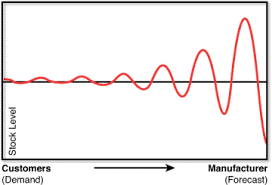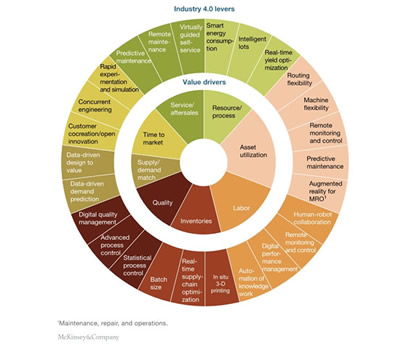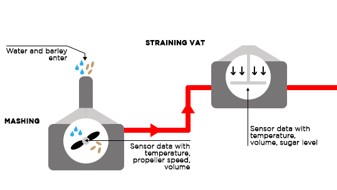- By Lanner
- In Blog
- Posted 29/03/2017
The scale and effects of Industry 4.0 are wide ranging, and have been frequently reported across many channels. A recent report widely circulated on social media by McKinsey claims that Industry 4.0 delivers inventory cost savings of 20-50%. With the ability to become more efficient and lean, Industry 4.0 threatens to disrupt every industry – particularly for those who delay adopting new technologies. To quote John Chambers, CEO of Cisco for over 20 years:
“40% of businesses in 10 years will not survive thanks to digital disruption”.
Beer and revolution
To illustrate the effects of the latest industrial revolution, and to suggest a management approach to decision-making regarding investment and adoption of technology, we revisit the well-known beer game.
The
beer game is a popular business simulation game created by a group of professors at MIT Sloan School of Management in early 1960s. The game is set around a supply chain that includes the roles of brewer, distributor, wholesaler and the publican who finally serves the consumer. The players assume one of these roles, then places orders for cases of beer with their predecessor in the supply chain. The parameters used in the game are simple; costs allocated against inventory and back orders, and additional fixed delays for order processing, shipping and production.

The game is used to demonstrate various aspects of supply chain management and famously illustrates the
'bull whip’ (or Forrester) effect. The players have no market information, just their own inventory level to refer to. They are not allowed to communicate with any other player, apart from placing orders for beer with their predecessor in the chain.

|
Unsurprisingly there is generally confusion amongst the participants about the ‘end to end’ supply chain and the real demand from consumers for beer. Almost without fail the ‘bull whip’ phenomenon is apparent as inventories fluctuate more wildly the further upstream they are in the supply chain, away from the real demand from drinkers.
|
Beer goggles and supply chain failings
The beer game has become the subject of extensive analysis by academics and consultants commenting on the underlying causes of the supply chain inefficiencies it demonstrates. The causes are many, but include a lack of visibility, feedback loops and the behavioral aspects influenced by competition between players as they fight for the profit available within the supply chain.

50 years after its invention, it is interesting and valuable to consider the effects of Industry 4.0 on the supply network described in the beer game. Industry 4.0 brings many new disruptive technologies that offer step change improvements for individual participants and the entire supply chain. There is even potential to drastically change business models completely.
Smart factories, connectivity (IOT) and advanced analytics are all part of Industry 4.0 and the digitization revolution. This diagram of the Industry 4.0 compass lists many of these emerging technologies and methodologies, and how they potentially influence value drivers in business.
How Industry 4.0 changes the beer game...
In the beer game, the brewer is faced with capacity constraints, variations in manufacturing in terms of quality and processing time due to the use of natural ingredients, and fluctuations in demand from his customer – the distributor.
...at the brewery level
Although basic automation first came to beer production many years ago, the emergence of IoT – sensors, data processing and the cloud – means the brewer has the opportunity to make step change improvements to their processes and products. Processing speed and product quality can be improved in real-time using plant sensors connected to advanced analytics or machine learning systems that are monitoring and controlling the beer making processes for instance. Furthermore, predictive maintenance systems can improve efficiency and reliability within the brewery.

The Brewery owner is faced with a dilemma - which technologies should be deployed, and in what combination to improve their competitive position? Simulation can be used to predict the performance of different investment scenarios, enabling the brewer to make better decisions and reduce operational risk.
...at the distributor level
Moving down the chain, the distributor is looking for faster more accurate stock picking, shorter dispatch times and reduced transport costs. They could deploy warehouse technology that provides direct links to stock control systems using headsets to deliver accurate guidance for manual stock pickers to enable higher accuracy and faster order fulfilment for instance. In the beer game scenario, using warehouse technology also supports better stock rotation to improving overall product quality for the consumer too. Ultimately you could imagine robotic stock pickers in a totally automated warehouse operating 24x7x365 for maximum efficiency and productivity. But like the brewer, the distributor must be able to justify the investment in improving his operation.
...at the logistics level
For the logistics firm tasked with moving beer between brewer, supplier and customer, driverless vehicles promise a significant improvement on current transportation methods. Autonomous vehicles can calculate optimum routes, guided by real time information on road and traffic conditions to balance speed and timeliness of delivery for maximum profit margin on every journey.
...at the bar level
Advanced analytics could be harnessed to predict beer consumption based upon historical data and other environmental factors, including those that exist outside the business, like weather forecasts. Analytics could also help the retailer manage demand by creating targeted offers and promotions to increase revenue and profits based on customer buying habits.
...across the supply chain as a whole
The largest efficiency gains in the supply chain would probably be achieved by increased visibility along the entire supply chain, achieved through shared real time data using increased connectivity. This would alleviate the ‘bull whip’ effect by making consumption data available to the beer producer direct, rather than having production being dictated by (wildly inaccurate) sales forecasts. Supply chain visibility allows every business involved to respond as quickly as possible to planned and unplanned events. The supply chain participants need to be as transparent as possible with their partners, adopting a more collaborative business model to increase productivity and reduce risks.
Industry 4.0 does offer business in many sectors huge opportunities to improve competitiveness and deliver real value in many aspects of our lives. The disruption to the way products and services are manufactured and delivered will be monumental. The challenge then becomes one of ‘change management’, about people and not technology. Predictive simulation is a valuable tool in building the awareness of new processes, involving stakeholders, to gain clarity and reduce uncertainty.